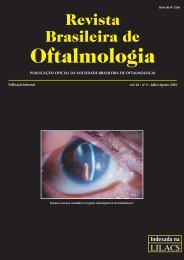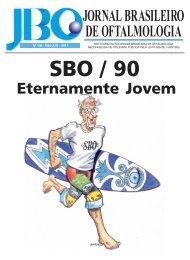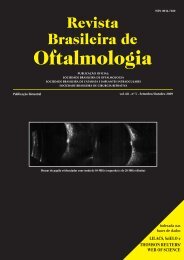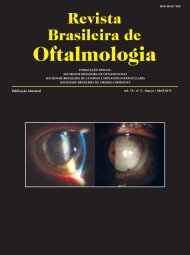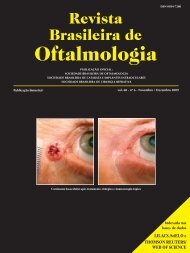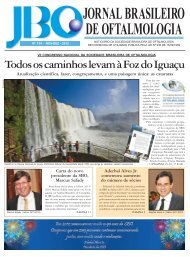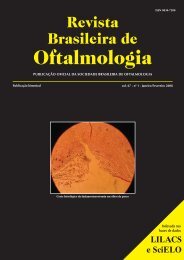Baixe aqui a versão em PDF da RBO - Sociedade Brasileira de ...
Baixe aqui a versão em PDF da RBO - Sociedade Brasileira de ...
Baixe aqui a versão em PDF da RBO - Sociedade Brasileira de ...
- No tags were found...
Create successful ePaper yourself
Turn your PDF publications into a flip-book with our unique Google optimized e-Paper software.
ARTIGO ORIGINAL99Dynamic ultra high speed Scheimpflug imagingfor assessing corneal biomechanical propertiesAvaliação Dinâmica com fotografia <strong>de</strong> Scheimpflug <strong>de</strong> altaveloci<strong>da</strong><strong>de</strong> para avaliar as proprie<strong>da</strong><strong>de</strong>s biomecânicas <strong>da</strong> córneaRenato Ambrósio Jr 1,2,3 , Isaac Ramos 1,2 , Allan Luz 2,3 , Fernando Correa Faria 1,2 , Andreas Steinmueller 4 ,Matthias Krug 4 , Michael W. Belin 5 , Cynthia Jane Roberts 6ABSTRACTObjective: To <strong>de</strong>scribe a novel technique for clinical characterization of corneal biomechanics using non-invasive dynamic imaging.Methods: Corneal <strong>de</strong>formation response during non contact tonometry (NCT) is monitored by ultra-high-speed (UHS) photography.The Oculus Corvis ST (Scheimpflug Technology; Wetzlar, Germany) has a UHS Scheimpflug camera, taking over 4,300 frames persecond and of a single 8mm horizontal slit, for monitoring corneal <strong>de</strong>formation response to NCT. The metered collimated air pulse orpuff has a symmetrical configuration and fixed maximal internal pump pressure of 25 kPa. The bidirectional mov<strong>em</strong>ent of the cornea inresponse to the air puff is monitored. Results: Measur<strong>em</strong>ent time is 30ms, with 140 frames acquired. Advanced algorithms for edge<strong>de</strong>tection of the front and back corneal contours are applied for every frame. IOP is calculated based on the first applanation moment.Deformation amplitu<strong>de</strong> (DA) is <strong>de</strong>termined as the highest displac<strong>em</strong>ent of the apex in the highest concavity (HC) moment. Applanationlength (AL) and corneal velocity (CVel) are recor<strong>de</strong>d during ingoing and outgoing phases. Conclusion: Corneal <strong>de</strong>formation can b<strong>em</strong>onitored during non contact tonometry. The parameters generated provi<strong>de</strong> clinical in vivo characterization of corneal biomechanicalproperties in two dimensions, which is relevant for different applications in Ophthalmology.Keywords: Biomechanics; Cornea/physiology; Corneal topography/methods; Tonometry, ocular/methodsRESUMOObjetivo: Descrever uma nova técnica para caracterização clínica <strong>da</strong>s proprie<strong>da</strong><strong>de</strong>s biomecânicas <strong>da</strong> córnea, usando sist<strong>em</strong>a <strong>de</strong>imag<strong>em</strong> dinâmica não invasivo. Métodos: A resposta <strong>de</strong> <strong>de</strong>formação <strong>da</strong> córnea é monitora<strong>da</strong> durante tonometria <strong>de</strong> não contatocom fotografia <strong>de</strong> Scheimpflug <strong>de</strong> altíssima veloci<strong>da</strong><strong>de</strong>. O Oculus Corvis ST (Scheimpflug Technology; Wetzlar, Germany) apresentauma câmera UHS Scheimpflug que adquire mais que 4.300 fotos por segundo com cobertura <strong>de</strong> 8mm horizontais para monitorar aresposta <strong>de</strong> <strong>de</strong>formação durante a tonometria <strong>de</strong> não contato por sopro <strong>de</strong> ar. O pulso <strong>de</strong> ar é muito b<strong>em</strong> controlado, apresentandouma configuração simétrica <strong>em</strong> sua pressão, com máxima pressão <strong>da</strong> bomba fixa <strong>de</strong> 25 kPa. O movimento bidirecional <strong>da</strong> córnea <strong>em</strong>resposta ao jato <strong>de</strong> ar é monitorado. Resultados: A medi<strong>da</strong> dura 30ms, com 140 fotos adquiri<strong>da</strong>s. Algorítmos avançados i<strong>de</strong>ntificamos limites anterior e posterior <strong>da</strong> córnea <strong>em</strong> ca<strong>da</strong> imag<strong>em</strong>. A pressão intraocular (PIO) é calcula<strong>da</strong> com base no primeiro momento<strong>de</strong> aplanação. A amplitu<strong>de</strong> <strong>de</strong> <strong>de</strong>formação é <strong>de</strong>termina<strong>da</strong> pelo maior <strong>de</strong>slocamento do ápice, durante o momento <strong>de</strong> maior concavi<strong>da</strong><strong>de</strong>.A extensão <strong>da</strong> aplanação e veloci<strong>da</strong><strong>de</strong> <strong>da</strong> córnea são medidos nas fases <strong>de</strong> entra<strong>da</strong> e saí<strong>da</strong>. Conclusão: A <strong>de</strong>formação <strong>da</strong> córneadurante a tonometria <strong>de</strong> sopro por pulso <strong>de</strong> ar po<strong>de</strong> ser monitora<strong>da</strong> <strong>em</strong> <strong>de</strong>talhe com sist<strong>em</strong>a <strong>de</strong> fotografia <strong>de</strong> altíssima veloci<strong>da</strong><strong>de</strong>.Os parâmetros gerados possibilitam caracterização clínica <strong>da</strong>s proprie<strong>da</strong><strong>de</strong>s biomecâmicas <strong>da</strong> córnea <strong>em</strong> duas dimensões. Taisachados têm relavância para diversas áreas <strong>da</strong> Oftalmologia.Descritores: Biomecânica; Córnea/fisiologia; Topografia <strong>da</strong> córnea/métodos; Tanometria ocular/métodos1Instituto <strong>de</strong> Olhos Renato Ambrósio – Rio <strong>de</strong> Janeiro (RJ), Brazil;2Rio <strong>de</strong> Janeiro Corneal Tomography and Biomechanics Study Group – Rio <strong>de</strong> Janeiro (RJ), Brazil;3Department of Ophthalmology, il;4Oculus GmbH - Wetzlar, Germany;5Ophthalmology, University of Arizona – Tucson, AZ, USA;6Ophthalmology, Department of Biomedical Engineering, The Ohio State University – Columbus, OH, USA.Financial Disclosure(s): Mr. Steinmueller, Mr. Krug are <strong>em</strong>ployee of Oculus; Dr. Ambrósio, Dr. Belin and Dr. Roberts are consultants for OculusRecebido para publicação <strong>em</strong>: 11/4/2012 - Aceito para publicação <strong>em</strong>: 3/12/2012Rev Bras Oftalmol. 2013; 72 (2): 99-102



